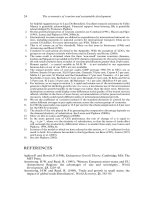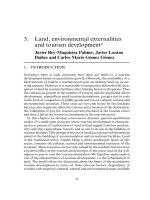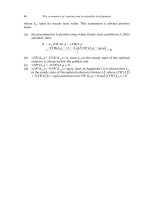THE ECONOMICS OF MONEY,BANKING, AND FINANCIAL MARKETS 557
Bạn đang xem bản rút gọn của tài liệu. Xem và tải ngay bản đầy đủ của tài liệu tại đây (42.82 KB, 1 trang )
CHAPTER 20
The International Financial System
525
As long as countries abided by the rules under the gold standard and kept
their currencies backed by and convertible into gold, exchange rates remained
fixed. However, adherence to the gold standard meant that a country had no
control over its monetary policy because its money supply was determined by
gold flows between countries. Furthermore, monetary policy throughout the
world was greatly influenced by the production of gold and gold discoveries.
When gold production was low in the 1870s and 1880s, the money supply
throughout the world grew slowly and did not keep pace with the growth of the
world economy. The result was deflation (falling price levels). Gold discoveries
in Alaska and South Africa in the 1890s greatly expanded gold production, causing money supplies to increase rapidly and price levels to rise (inflation) until
World War I.
The Bretton
Woods
System
After World War II, the victors set up a fixed exchange rate system that became
known as the Bretton Woods system, after the New Hampshire town in which
the agreement was negotiated in 1944. The Bretton Woods system was in effect
until 1971.
The Bretton Woods agreement created the International Monetary Fund
(IMF), headquartered in Washington, D.C., which had 30 original member countries in 1945 and currently has 180. The IMF was given the task of promoting the
growth of world trade by setting rules for the maintenance of fixed exchange rates
and by making loans to countries that were experiencing balance-of-payments
difficulties. As part of its role of monitoring the compliance of member countries
with its rules, the IMF also took on the job of collecting and standardizing international economic data.
The Bretton Woods agreement also set up the International Bank for
Reconstruction and Development, commonly referred to as the World Bank, also
headquartered in Washington, D.C., which provides long-term loans to help developing countries build dams, roads, and other physical capital that would contribute to their economic development. The funds for these loans are obtained
primarily by issuing World Bank bonds, which are sold in the capital markets of
the developed countries. In addition, the General Agreement on Tariffs and Trade
(GATT), headquartered in Geneva, was set up to monitor rules for the conduct of
trade between countries (tariffs and quotas) and the GATT has evolved into the
World Trade Organization (WTO).
Because the United States emerged from World War II as the world s largest
economic power, with over half of the world s manufacturing capacity and the
greater part of the world s gold, the Bretton Woods system of fixed exchange
rates was based on the convertibility of U.S. dollars into gold (for foreign
governments and central banks only) at US$35 per ounce. The fixed exchange
rates were to be maintained by intervention in the foreign exchange market
by central banks in countries besides the United States who bought and sold
U.S. dollar assets, which they held as international reserves. The U.S. dollar,
which was used by other countries to denominate the assets that they held as
international reserves, was called the reserve currency. Thus an important
feature of the Bretton Woods system was the establishment of the United States
as the reserve currency country. Even after the breakup of the Bretton Woods
system, the U.S. dollar has kept its position as the reserve currency in which
most international financial transactions are conducted. However, with the creation of the euro in 1999, the supremacy of the U.S. dollar may be subject to a
serious challenge (see the Global box, The Euro s Challenge to the U.S. Dollar).









